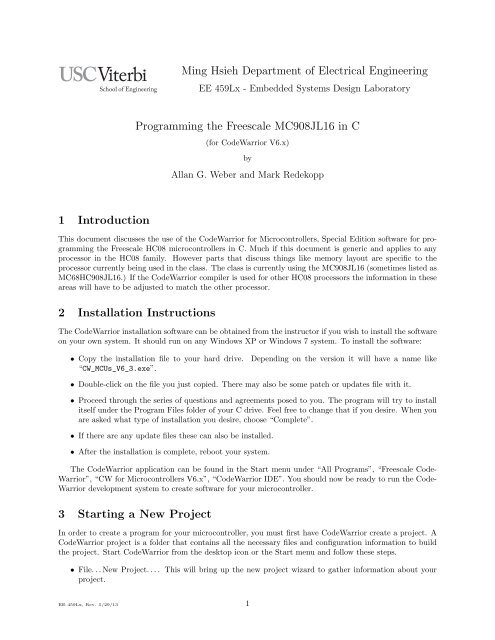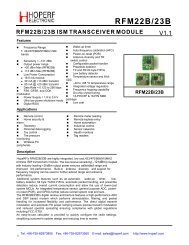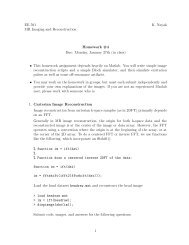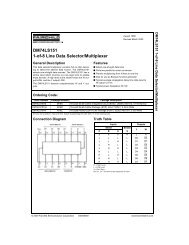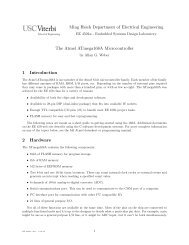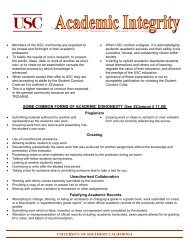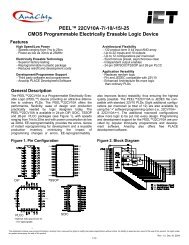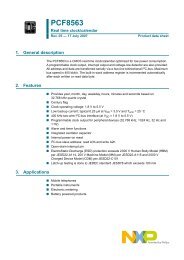Ming Hsieh Department of Electrical Engineering Programming the ...
Ming Hsieh Department of Electrical Engineering Programming the ...
Ming Hsieh Department of Electrical Engineering Programming the ...
Create successful ePaper yourself
Turn your PDF publications into a flip-book with our unique Google optimized e-Paper software.
1 Introduction<br />
<strong>Ming</strong> <strong>Hsieh</strong> <strong>Department</strong> <strong>of</strong> <strong>Electrical</strong> <strong>Engineering</strong><br />
EE 459Lx - Embedded Systems Design Laboratory<br />
<strong>Programming</strong> <strong>the</strong> Freescale MC908JL16 in C<br />
(for CodeWarrior V6.x)<br />
by<br />
Allan G. Weber and Mark Redekopp<br />
This document discusses <strong>the</strong> use <strong>of</strong> <strong>the</strong> CodeWarrior for Microcontrollers, Special Edition s<strong>of</strong>tware for programming<br />
<strong>the</strong> Freescale HC08 microcontrollers in C. Much if this document is generic and applies to any<br />
processor in <strong>the</strong> HC08 family. However parts that discuss things like memory layout are specific to <strong>the</strong><br />
processor currently being used in <strong>the</strong> class. The class is currently using <strong>the</strong> MC908JL16 (sometimes listed as<br />
MC68HC908JL16.) If <strong>the</strong> CodeWarrior compiler is used for o<strong>the</strong>r HC08 processors <strong>the</strong> information in <strong>the</strong>se<br />
areas will have to be adjusted to match <strong>the</strong> o<strong>the</strong>r processor.<br />
2 Installation Instructions<br />
The CodeWarrior installation s<strong>of</strong>tware can be obtained from <strong>the</strong> instructor if you wish to install <strong>the</strong> s<strong>of</strong>tware<br />
on your own system. It should run on any Windows XP or Windows 7 system. To install <strong>the</strong> s<strong>of</strong>tware:<br />
• Copy <strong>the</strong> installation file to your hard drive. Depending on <strong>the</strong> version it will have a name like<br />
“CW_MCUs_V6_3.exe”.<br />
• Double-click on <strong>the</strong> file you just copied. There may also be some patch or updates file with it.<br />
• Proceed through <strong>the</strong> series <strong>of</strong> questions and agreements posed to you. The program will try to install<br />
itself under <strong>the</strong> Program Files folder <strong>of</strong> your C drive. Feel free to change that if you desire. When you<br />
are asked what type <strong>of</strong> installation you desire, choose “Complete”.<br />
• If <strong>the</strong>re are any update files <strong>the</strong>se can also be installed.<br />
• After <strong>the</strong> installation is complete, reboot your system.<br />
The CodeWarrior application can be found in <strong>the</strong> Start menu under “All Programs”, “Freescale Code-<br />
Warrior”, “CW for Microcontrollers V6.x”, “CodeWarrior IDE”. You should now be ready to run <strong>the</strong> Code-<br />
Warrior development system to create s<strong>of</strong>tware for your microcontroller.<br />
3 Starting a New Project<br />
In order to create a program for your microcontroller, you must first have CodeWarrior create a project. A<br />
CodeWarrior project is a folder that contains all <strong>the</strong> necessary files and configuration information to build<br />
<strong>the</strong> project. Start CodeWarrior from <strong>the</strong> desktop icon or <strong>the</strong> Start menu and follow <strong>the</strong>se steps.<br />
• File. . . New Project. . . . This will bring up <strong>the</strong> new project wizard to ga<strong>the</strong>r information about your<br />
project.<br />
EE 459Lx, Rev. 5/29/13 1
• On <strong>the</strong> Device and Connection screen select <strong>the</strong> microcontroller you will be using. For most <strong>of</strong> <strong>the</strong><br />
class projects it should be <strong>the</strong> MC68HC908JL16. Open up <strong>the</strong> “HC08” list and <strong>the</strong>n open <strong>the</strong> “JK/JL<br />
Family” list. Click on <strong>the</strong> microcontroller being used.<br />
In <strong>the</strong> “Connections” box, select “P&E Multilink/Cyclone Pro” if you will be using <strong>the</strong> USB programming<br />
hardware, or “Mon08 Interface” to use <strong>the</strong> Freescale development boards. See Sec. 9 for more<br />
information on <strong>the</strong> programming hardware. Click “Next”.<br />
• On <strong>the</strong> Project Parameters screen, select <strong>the</strong> programming language. C is recommended since it allows<br />
for larger projects. Selecting C++ limits <strong>the</strong> program size to only 1KB. Type a project a name in <strong>the</strong><br />
text box. CodeWarrior will create a folder <strong>of</strong> this name under your “My Documents” folder or you can<br />
change <strong>the</strong> location. Click “Next”.<br />
• On <strong>the</strong> Add Additional Files screen you can add source files to <strong>the</strong> project (this can also be done later.)<br />
Select <strong>the</strong> files to add and <strong>the</strong>n click on “Add”. If <strong>the</strong> “Copy files to project” button is selected <strong>the</strong><br />
files will be copied into <strong>the</strong> “Sources” folder in <strong>the</strong> project folder <strong>the</strong> new project wizard is creating.<br />
Use this option if you are going to create your project by modifying one <strong>of</strong> <strong>the</strong> demo or template files.<br />
If this option is not selected, <strong>the</strong> source files are left in <strong>the</strong>ir original location.<br />
One file in <strong>the</strong> project must contain <strong>the</strong> “main()” routine. If <strong>the</strong> “Create main.c/main.asm file” box<br />
is checked, CodeWarrior will add a main.c file to your project containing this routine. You can later<br />
edit this file to add your own code. Alternatively you can uncheck <strong>the</strong> main.c box and add your own<br />
file that contains a main routine. This method is easier if you are copying a main program from some<br />
o<strong>the</strong>r project. However it is done <strong>the</strong>re must be one, and only one, file that contains a main routine.<br />
Click “Next”.<br />
• On <strong>the</strong> Processor Expert screen, select “None” when it asks about Rapid Application Development<br />
Options. Click “Next”.<br />
• On <strong>the</strong> C/C++ Options screen:<br />
– Select “ANSI startup code”.<br />
– For <strong>the</strong> memory model select “Small”. The small memory model allows access to all <strong>of</strong> <strong>the</strong> 512<br />
bytes <strong>of</strong> RAM in <strong>the</strong> JL16 processor. If you know you only need a few bytes <strong>of</strong> RAM you can select<br />
<strong>the</strong> “Tiny” memory model which restricts access to only 160 bytes. It’s highly recommended that<br />
you use <strong>the</strong> “Small” model.<br />
– For floating point, select “None” if your project has no need to do calculations in floating point<br />
arithmetic. If your project requires doing floating point calculations, select one <strong>of</strong> <strong>the</strong> choices for<br />
<strong>the</strong> size <strong>of</strong> “double” variables, ei<strong>the</strong>r 32 bits or 64 bits. In ei<strong>the</strong>r case “float” variables will be<br />
32 bits. For more on using floating point see Sec. 5.11.<br />
– Click “Next”;<br />
• On <strong>the</strong> PC-Lint screen select “No”. Click on “Finish”.<br />
At this point CodeWarrior will create <strong>the</strong> project folder and bring up <strong>the</strong> project window.<br />
4 Navigating Through Your Project<br />
After CodeWarrior creates your project you will see <strong>the</strong> project window as shown in Figure 1. In <strong>the</strong> left-hand<br />
window pane you will see a folder structure for <strong>the</strong> files that are part <strong>of</strong> your project.<br />
• The “Sources” folder contains your source files. In that folder you should see <strong>the</strong> files you asked to be<br />
added to your project. If you didn’t add any and selected <strong>the</strong> option to have CodeWarrior create a<br />
main.c it will show up here and you can ei<strong>the</strong>r edit main.c or replace it with ano<strong>the</strong>r file. If you choose<br />
to replace it, use <strong>the</strong> “Remove” command under <strong>the</strong> Edit menu to delete main.c from <strong>the</strong> project, <strong>the</strong>n<br />
use <strong>the</strong> “Add Files” command under <strong>the</strong> Project menu to add a different main program file. O<strong>the</strong>r C<br />
files can also be added to <strong>the</strong> project. Double-clicking <strong>the</strong> file will open it in <strong>the</strong> CodeWarrior editor.<br />
EE 459Lx, Rev. 5/29/13 2
Figure 1: New C Language Project Structure<br />
• The “Includes” folder contains files specific to model <strong>of</strong> microcontroller you are using. Your program<br />
should reference <strong>the</strong> “derivative.h” file which <strong>the</strong>n references <strong>the</strong> correct include file for your microcontroller.<br />
These files declare variable names you can use to read and write <strong>the</strong> internal registers <strong>of</strong><br />
your microcontroller. It also defines bit names that allow you to read, set, or clear any bit in one <strong>of</strong><br />
<strong>the</strong> internal registers. You should use <strong>the</strong>se variables ra<strong>the</strong>r than trying to create your own system <strong>of</strong><br />
addressing <strong>the</strong> internal registers.<br />
• The “Libs” Folder contains files to support <strong>the</strong> specific model <strong>of</strong> microcontroller being used as well as<br />
<strong>the</strong> ANSI-C libraries you may use. There should not be any reason to modify <strong>the</strong> files in this folder.<br />
• The “Startup Code” folder contains code used to allow <strong>the</strong> processor to run C-language code. You<br />
should NOT modify this code.<br />
• The “Linker Files” folder, contains files used <strong>the</strong> CodeWarrior program to compile and link your<br />
program. The only file you should be interested in is <strong>the</strong> “.prm” file that specifies <strong>the</strong> overall memory<br />
map <strong>of</strong> your program and also provides <strong>the</strong> ability to register your interrupt service routines (ISR’s).<br />
Initially a new project has a file named “Project.prm” in this folder. As with <strong>the</strong> main C program file,<br />
you can ei<strong>the</strong>r edit this file or remove it and replace it with ano<strong>the</strong>r. See Sec. 6 for more information.<br />
5 Writing Code<br />
Writing C code to be run on a microcontroller requires you to manage some <strong>of</strong> <strong>the</strong> low-level details <strong>of</strong> <strong>the</strong><br />
system since a microcontroller has no operating system. Not only are you writing <strong>the</strong> application to be run on<br />
<strong>the</strong> system but also <strong>the</strong> essential portions <strong>of</strong> OS code. The low-level details you must manage include reading<br />
and writing internal registers, writing assembly routines, registering interrupt service routines, dealing with<br />
memory addressing issues, and some basic optimization issues.<br />
EE 459Lx, Rev. 5/29/13 3
More information can be found in <strong>the</strong> HC08 Manuals included with CodeWarrior, namely <strong>the</strong> Compiler<br />
reference and Linker reference. Copies <strong>of</strong> <strong>the</strong>se manuals in PDF format can be found on <strong>the</strong> EE 459Lx web<br />
site.<br />
5.1 Program Initialization<br />
CodeWarrior automatically includes in a project <strong>the</strong> necessary start-up code to do things like initialize global<br />
variables and set up <strong>the</strong> processor stack.<br />
The HC08 processors have a “Computer Operating Properly” (COP) timer that will cause <strong>the</strong> processor<br />
to execute a reset operation if <strong>the</strong> COP timer isn’t cleared before it overflows. This is to prevent <strong>the</strong> chip<br />
from becoming essentially dead due to a runaway program.<br />
For <strong>the</strong> programs in EE 459 <strong>the</strong> COP function isn’t normally needed so <strong>the</strong> COP timer should be disabled.<br />
Put ano<strong>the</strong>r way, <strong>the</strong> COP timer MUST be disabled unless your program includes <strong>the</strong> instructions to reset<br />
<strong>the</strong> timer periodically. Disabling <strong>the</strong> COP timer can be done with <strong>the</strong> instruction below, preferably near <strong>the</strong><br />
start <strong>of</strong> <strong>the</strong> program.<br />
CONFIG1_COPD = 1; // disable COP reset<br />
5.2 Program Termination<br />
Unlike writing a program on a larger computer, <strong>the</strong> microcontroller does not have an operating system that<br />
can take over control once <strong>the</strong> program is finished and exits. This means <strong>the</strong> program should never exit. It<br />
should always be doing something, such as running in an endless loop.<br />
while (1) {<br />
}<br />
If you are not using interrupts, you can also include <strong>the</strong> assembly language instruction “WAIT” at <strong>the</strong> end<br />
<strong>of</strong> <strong>the</strong> program which essentially makes <strong>the</strong> processor stop and wait for <strong>the</strong> next interrupt to occur.<br />
5.3 Declaring Variables<br />
In most cases memory can be allocated <strong>the</strong> same as it would with any C program. However <strong>the</strong> microcontrollers<br />
have much less memory than is available for C programs on a general purpose computer so it is<br />
important to make efficient use it. Fixed-point variables, as opposed to floating point variables, should be<br />
used whenever possible since <strong>the</strong>y take up less space in memory. The JL16 processor does not have internal<br />
floating point hardware so using floating point can slow down execution speed and increase program size. If<br />
<strong>the</strong> program requires floating point, see Sec. 5.11 for tips on using it.<br />
The native size for operating on data in <strong>the</strong> microcontroller is 8 bits. Whenever possible variables should<br />
be declared as 8-bit values in order to reduce both <strong>the</strong> amount <strong>of</strong> RAM memory used and <strong>the</strong> amount <strong>of</strong><br />
code generated to operate on <strong>the</strong> variables. Unless a values being stored in a variable are known to exceed<br />
<strong>the</strong> limits <strong>of</strong> 8-bits, variables (and functions) should be declared as ei<strong>the</strong>r “unsigned char” for unsigned 0<br />
to 255 values, or “signed char” for -128 to +127 values. Variables can also be declared as type “byte”<br />
which is defined as an unsigned char. The table below summarizes <strong>the</strong> sizes and ranges <strong>of</strong> <strong>the</strong> fixed-point<br />
variables.<br />
Depending on <strong>the</strong> C compiler <strong>the</strong> type “char” is sometimes implemented as <strong>the</strong> same as unsigned char<br />
and sometimes <strong>the</strong> same as signed char. To avoid confusion, it’s recommended that you always declare <strong>the</strong><br />
variable with ei<strong>the</strong>r <strong>the</strong> signed or unsigned modifier. The types “int8_t”, “uint8_t”, “int16_t”, etc. that<br />
are defined in some C compilers are not supported in CodeWarrior unless you define <strong>the</strong>se yourself.<br />
Using <strong>the</strong> smallest variable type necessary is also important for improving execution times in <strong>the</strong> program.<br />
Since <strong>the</strong> processor can only operate on 8-bit (single byte) quantities, whenever it has to add two or four<br />
bytes quantities this requires multiple instructions. Using a two or four byte variable for something like a<br />
loop index can cause <strong>the</strong> loop to run much slower than expected due to <strong>the</strong> amount <strong>of</strong> work that has to be<br />
done each time <strong>the</strong> index is incremented.<br />
EE 459Lx, Rev. 5/29/13 4
5.4 Memory Models<br />
Full Name Short Name # Bytes Min Max<br />
unsigned char byte or char 1 0 255<br />
signed char 1 -128 +127<br />
unsigned short word 2 0 65535<br />
signed short short 2 -32768 32767<br />
unsigned int 2 0 65535<br />
signed int int 2 -32768 32767<br />
unsigned long 4 0 4294967295<br />
signed long long 4 -2147483648 2147483647<br />
Table 1: Fixed-Point Variable Ranges<br />
RAM space on <strong>the</strong> JL16 is very limited, only 512 bytes, and not all <strong>of</strong> it is available for use by your program.<br />
As shown in Fig. 2, <strong>the</strong> RAM occupies addresses from 0x060 to 0x25F in <strong>the</strong> addressing space. The 160<br />
bytes from 0x060 to 0x0FF is in <strong>the</strong> “direct page” or “zero page” since <strong>the</strong> upper byte <strong>of</strong> <strong>the</strong> address is zero<br />
and can be accessed using 8-bit addresses. The rest <strong>of</strong> <strong>the</strong> RAM (from 0x100 to 0x25F) needs to be accessed<br />
with 16-bit addresses.<br />
If <strong>the</strong> “Tiny” memory model was selected during <strong>the</strong> project creation, all memory accesses use 8-bit<br />
addresses which means only <strong>the</strong> portion <strong>of</strong> RAM in <strong>the</strong> zero-page is accessible. If <strong>the</strong> “Small” memory<br />
model was selected during <strong>the</strong> project creation <strong>the</strong> compiler will generate 16-bit addresses for all memory<br />
accesses and <strong>the</strong> full 512 bytes are usable. For this reason it is recommended that <strong>the</strong> “Small” memory<br />
model be used for all projects.<br />
The programmer can decide which region to allocate variables in (see Sec. 5.6) but does not have to<br />
be concerned with how <strong>the</strong>y are accessed. The compiler will generate <strong>the</strong> proper code, ei<strong>the</strong>r 8 or 16-bit<br />
addresses, to access <strong>the</strong> variables.<br />
5.5 Stack Space<br />
The ”stack” is a portion <strong>of</strong> memory used by <strong>the</strong> processor and programs to store temporary data. The<br />
amount <strong>of</strong> memory available for <strong>the</strong> stack is limited and misuse <strong>of</strong> <strong>the</strong> stack space on <strong>the</strong> JL16 is one <strong>of</strong><br />
<strong>the</strong> more common reasons that programs do not execute as expected. As can be seen from Fig. 2 <strong>the</strong> stack<br />
starts at location 0x0FF and as data and addresses are pushed onto <strong>the</strong> stack it grows downward towards<br />
<strong>the</strong> area where global variables are stored. If too many variables are pushed on <strong>the</strong> stack it is very likely<br />
that <strong>the</strong> stack will grow downward too much and eventually overwrite <strong>the</strong> contents <strong>of</strong> <strong>the</strong> global variables.<br />
Note that <strong>the</strong>re is no mechanism in <strong>the</strong> JL16 to prevent putting too much data on <strong>the</strong> stack. The stack data<br />
can overwrite global variables, and writing to global variables can overwrite stack data, ei<strong>the</strong>r <strong>of</strong> which can<br />
cause big problems for <strong>the</strong> program.<br />
When writing code, <strong>the</strong> programmer should be aware <strong>of</strong> roughly how much stack space <strong>the</strong>y are using.<br />
Each time a function is called several things happen. First, all <strong>of</strong> <strong>the</strong> arguments to <strong>the</strong> function are pushed<br />
onto <strong>the</strong> stack. If a function has arguments <strong>of</strong> four 16-bit “int” values, this causes eight bytes to go on <strong>the</strong><br />
stack. Next <strong>the</strong> processor pushes <strong>the</strong> two bytes for <strong>the</strong> return address on <strong>the</strong> stack. Lastly, space is allocated<br />
on <strong>the</strong> stack for all <strong>the</strong> local variables that are declared in <strong>the</strong> function. The combination <strong>of</strong> <strong>the</strong>se actions<br />
can cause a significant amount <strong>of</strong> stack space to be consumed each time a function is called. The space is<br />
recovered when <strong>the</strong> function exits and control returns to <strong>the</strong> calling function. However if one function calls<br />
ano<strong>the</strong>r, which calls ano<strong>the</strong>r, etc., <strong>the</strong> amount <strong>of</strong> stack space used can grow beyond what is available. As<br />
can be seen from <strong>the</strong> memory map, even if no global variables are allocated below <strong>the</strong> stack, it only has<br />
room for 160 bytes.<br />
When writing code, <strong>the</strong> following guidelines can help to avoid stack problems.<br />
• Avoid allocating large amounts <strong>of</strong> local variables. For example, if your functions need a temporary<br />
buffer <strong>of</strong> 80 bytes in order to do some task, do not declare an array <strong>of</strong> 80 unsigned bytes in <strong>the</strong><br />
function since <strong>the</strong>se will all be allocated on <strong>the</strong> stack. Instead consider using a global variable array<br />
EE 459Lx, Rev. 5/29/13 5
Address<br />
0x0260<br />
0x025F<br />
RAM<br />
(512 bytes)<br />
0x0100<br />
0x00FF<br />
0x0060<br />
0x0000<br />
Global variable area<br />
Stack Area<br />
Global variable area<br />
Device Registers<br />
Direct Page<br />
Region<br />
0x0000 - 0x00FF<br />
Figure 2: Memory Map <strong>of</strong> JL16 RAM<br />
<strong>of</strong> 80 bytes, perhaps one that can be shared with some o<strong>the</strong>r functions that is not called at <strong>the</strong> same<br />
time. Even though good programming practice suggests not using global variables, <strong>the</strong> use <strong>of</strong> global<br />
variables is <strong>of</strong>ten <strong>the</strong> best way to prevent problems with <strong>the</strong> stack.<br />
• Avoid passing a data structure by value to a function. If <strong>the</strong> “struct” is passed by value, <strong>the</strong>n<br />
<strong>the</strong> calling routine puts all <strong>the</strong> values in <strong>the</strong> structure on <strong>the</strong> stack before jumping to <strong>the</strong> start <strong>of</strong><br />
<strong>the</strong> function. A better way is probably to pass <strong>the</strong> structure by reference by passing a pointer to <strong>the</strong><br />
structure ra<strong>the</strong>r than <strong>the</strong> values.<br />
• Do not write programs that use recursion. Recursion is when a function calls itself and this<br />
practice can lead to excessive use <strong>of</strong> stack memory. If you think your program needs to operate<br />
recursively, try to find ano<strong>the</strong>r way to implement <strong>the</strong> program.<br />
There is a parameter in <strong>the</strong> linker parameter file (.prm file) that determines how much space is allocated<br />
for <strong>the</strong> stack (see Sec. 6). This value can be increased if your program needs more stack space but be<br />
aware that it doesn’t fully solve <strong>the</strong> problems described above. The parameter defines <strong>the</strong> size <strong>of</strong> <strong>the</strong> stack<br />
and causes <strong>the</strong> linker to not allocate variables above what should be <strong>the</strong> lower boundary <strong>of</strong> <strong>the</strong> stack. For<br />
example, <strong>the</strong> default stack size is 0x050 (80 bytes) and this means <strong>the</strong> stack is expected to occupy <strong>the</strong> space<br />
from 0x0FF down to 0x0B0. The linker will <strong>the</strong>n not allocate any variables above <strong>the</strong> address <strong>of</strong> 0x0B0.<br />
However, this doesn’t prevent <strong>the</strong> stack from growing downward into <strong>the</strong> area below 0x0B0 if <strong>the</strong> program<br />
causes that to happen. In o<strong>the</strong>r words, <strong>the</strong> stack size parameter allocates space for <strong>the</strong> stack, but it is up to<br />
<strong>the</strong> programmer to make sure it stays within that area.<br />
5.6 Using Direct Page Memory<br />
As seen from Fig. 2 some <strong>of</strong> <strong>the</strong> RAM memory <strong>of</strong> <strong>the</strong> JL16 lies in <strong>the</strong> direct page or zero page <strong>of</strong> <strong>the</strong><br />
addressing space. When global variables are allocated in a C program, <strong>the</strong> default area <strong>of</strong> RAM to put <strong>the</strong>m<br />
EE 459Lx, Rev. 5/29/13 6
Figure 3: OBJECT-ALLOCATION SECTION <strong>of</strong> <strong>the</strong> project map<br />
when using <strong>the</strong> “Small” memory model is from 0x100 to 0x25F. Unfortunately this means that <strong>the</strong>re will<br />
most likely be available RAM in <strong>the</strong> zero page (from 0x60 to 0x100) that is not being used. In order to use<br />
this part <strong>of</strong> <strong>the</strong> RAM, it is necessary to explicitly tell <strong>the</strong> compiler to allocate variables into <strong>the</strong> zero page.<br />
This is done with <strong>the</strong> statement<br />
# pragma DATA_SEG __SHORT_SEG MY_ZEROPAGE<br />
Any variables declared after this statement will be allocated in <strong>the</strong> zero page. To return to allocating<br />
variables in <strong>the</strong> default area <strong>of</strong> RAM, use <strong>the</strong> statement<br />
# pragma DATA_SEG DEFAULT<br />
5.7 Using ROM Memory<br />
Constant values such as arrays containing character strings that will not be modified can be allocated in<br />
ei<strong>the</strong>r RAM or ROM. Since RAM space is very limited, it’s normally a good idea to allocate <strong>the</strong>se in ROM.<br />
Use <strong>the</strong> “const” keyword to make <strong>the</strong> compiler and linker put constant values in ROM. For example:<br />
const unsigned char string5 [] = " This is a string ";<br />
const float pi = 3.14159;<br />
5.8 The Linker “.map” File<br />
When your program successfully compiles and is linked toge<strong>the</strong>r, <strong>the</strong> linker will create a map file that shows<br />
where all <strong>the</strong> procedures and variables have been allocated in ROM and RAM. The information in this file<br />
can be very useful for determining whe<strong>the</strong>r or not <strong>the</strong>re are potential memory allocation and usage problems.<br />
In <strong>the</strong> file structure for your project look in <strong>the</strong> “Project Settings” folder and <strong>the</strong>n in <strong>the</strong> “Linker Files”<br />
folder and open <strong>the</strong> “Project.map” file. In <strong>the</strong> file look for a section called “OBJECT-ALLOCATION<br />
SECTION”. This section will list each <strong>of</strong> <strong>the</strong> modules that make up your program and show where <strong>the</strong><br />
procedures and data are being stored in ROM and RAM. For each module, <strong>the</strong>re should be a heading <strong>of</strong><br />
“VARIABLES” and below that <strong>the</strong> names and addresses <strong>of</strong> all <strong>the</strong> variables allocated in <strong>the</strong> module. This<br />
information in this section can be used to make sure that <strong>the</strong> variables and constants are allocated in <strong>the</strong><br />
proper part <strong>of</strong> memory. The amount <strong>of</strong> memory being used for variables is also listed and this can be used<br />
to spot where excessive amounts <strong>of</strong> RAM memory are perhaps being used. Note that this table <strong>of</strong> variables<br />
includes all <strong>the</strong> values that allocated in ROM using <strong>the</strong> “const” declaration, which aren’t really variables<br />
but <strong>the</strong>y show up in this table anyway.<br />
Below <strong>the</strong> “OBJECT-ALLOCATION SECTION”, <strong>the</strong> file contains <strong>the</strong> “MODULE STATISTIC” section<br />
that summarizes <strong>the</strong> amount <strong>of</strong> RAM and ROM that <strong>the</strong> program is using. The “Data” colums shows <strong>the</strong><br />
RAM usage, while <strong>the</strong> combination <strong>of</strong> <strong>the</strong> “Code” and “Const” columns show <strong>the</strong> amount <strong>of</strong> ROM usage. If<br />
EE 459Lx, Rev. 5/29/13 7
Figure 4: MODULE STATISTIC portion <strong>of</strong> <strong>the</strong> project map<br />
Figure 5: DEPENDENCY TREE portion <strong>of</strong> <strong>the</strong> project map<br />
you think you have run out <strong>of</strong> space in RAM for storing variables, this <strong>the</strong> section to check to see how much<br />
space is being used.<br />
Towards <strong>the</strong> end <strong>of</strong> <strong>the</strong> map file is a section called “DEPENDENCY TREE” that shows a map <strong>of</strong> how<br />
<strong>the</strong> various functions in <strong>the</strong> program call each o<strong>the</strong>r. This diagram can be very useful to get an idea <strong>of</strong><br />
how deep <strong>the</strong> program goes with functions calling o<strong>the</strong>r functions. As discussed above each function pushes<br />
arguments on <strong>the</strong> stack and allocates data in <strong>the</strong> stack space so a dependency tree that shows a very deep<br />
tree <strong>of</strong> functions calls may indicate potential problems with using too much stack memory.<br />
The dependency tree will also indicate if <strong>the</strong>re are any recursive functions calls where a function is calling<br />
itself. Recursive functions can be used on <strong>the</strong> JL16 but due to <strong>the</strong>ir potential to use up large amounts <strong>of</strong><br />
stack space <strong>the</strong>y can be a source <strong>of</strong> problems. If you see an function flagged in <strong>the</strong> map file as being called<br />
recursively, first make sure that this is something you intended to do. It is easy to make an error in <strong>the</strong><br />
program that results in recursive calls that <strong>the</strong> programmer is not aware <strong>of</strong>. Unless <strong>the</strong>re is a very strong<br />
reason to use recursive function calls, it is highly recommended that <strong>the</strong>y be avoided.<br />
5.9 Function Prototypes<br />
There have been problems in <strong>the</strong> past with <strong>the</strong> compiler generating code that was essentially incorrect due<br />
to confusion over <strong>the</strong> size <strong>of</strong> address pointers. This only resulted when functions did not have prototypes<br />
that explicitly declared <strong>the</strong> type <strong>of</strong> all <strong>the</strong> parameters. To be on <strong>the</strong> safe side, always provide a prototype<br />
at <strong>the</strong> start <strong>of</strong> <strong>the</strong> program for all functions that are in <strong>the</strong> program.<br />
5.10 Reading and Writing Internal Registers<br />
All <strong>the</strong> internal registers (and bits within <strong>the</strong> registers) in <strong>the</strong> microcontroller are defined by variables and<br />
can be read and written in <strong>the</strong> same manner as any o<strong>the</strong>r C variable. The names for <strong>the</strong> registers and<br />
individual register bits are defined in <strong>the</strong> header file MC68HC908JL16.h which is accessible from <strong>the</strong> “Libs”<br />
folder in your project. A more readable summary <strong>of</strong> <strong>the</strong> information in this file is available on <strong>the</strong> class web<br />
site. Use that file to find <strong>the</strong> name <strong>of</strong> any register or bit you need to access in your C program.<br />
EE 459Lx, Rev. 5/29/13 8
Register Name Hexadecimal Address<br />
PTA 0x0000<br />
PTB 0x0001<br />
PTD 0x0003<br />
DDRA 0x0004<br />
DDRB 0x0005<br />
DDRD 0x0007<br />
Table 2: I/O Register Names and Addresses<br />
For example, ports A, B, and D are defined by variables named PTA, PTB, and PTD. You may perform<br />
operations on <strong>the</strong>se variables just as you would any o<strong>the</strong>r.<br />
PTA = 0 xf4 ;<br />
PTD = 5 * PTB + 2;<br />
unsigned char my_var = PTA ;<br />
PTB += 1;<br />
Individual bits in <strong>the</strong> registers can be accessed using <strong>the</strong> names defined for each bit. For example, <strong>the</strong> name<br />
PTA_PTA0 will access <strong>the</strong> LSB <strong>of</strong> Port A.<br />
PTB_PTB4 = 1;<br />
if ( PTD_PTD2 == 0) { ... }<br />
Alternatively, you can use bitwise operations such as AND and OR.<br />
bit0 = PTA & 0 x01 ;<br />
bit3 = PTA & 0 x08 ;<br />
When writing individual bits in <strong>the</strong> registers it is important to be aware that this will cause <strong>the</strong> microcontroller<br />
to first read <strong>the</strong> full eight-bit byte, modify <strong>the</strong> byte, and <strong>the</strong>n write <strong>the</strong> full byte back. Some <strong>of</strong><br />
<strong>the</strong> internal functions <strong>of</strong> <strong>the</strong> microcontroller are affected by reading a register so it is important to be aware<br />
<strong>of</strong> any potential side effects when accessing <strong>the</strong> registers.<br />
5.10.1 Defining Groups <strong>of</strong> Register Bits<br />
In some applications groups <strong>of</strong> bits in <strong>the</strong> I/O registers are part <strong>of</strong> a multi-bit quantity and it is preferable<br />
to refer to all <strong>the</strong> bits toge<strong>the</strong>r ra<strong>the</strong>r than individually. Groups <strong>of</strong> bits can be defined as a single quantity<br />
and operations can be performed on <strong>the</strong>m as a group. For example, let’s assume we want to refer to port<br />
B, bits 1, 2 and 3 as a three bit quantity (VidMode), and to also refer to bits 6 and 7 as a two bit quantity<br />
(RAMSel). The following code defines <strong>the</strong>se groups <strong>of</strong> bits.<br />
volatile struct {<br />
unsigned char :1; /* bit 0 ( LSB ) - no name assigned */<br />
unsigned char VidMode :3; /* bits 1 -3 = VidMode */<br />
unsigned char :2; /* bits 4 -5 - no name assigned */<br />
unsigned char RAMSel :2; /* bits 6 -7 ( MSB ) = RAMSel */<br />
} MyPTB @0x0001 ; /* 0 x0001 = address <strong>of</strong> PTB */<br />
# define VidMode MyPTB . VidMode<br />
# define RAMSel MyPTB . RAMSel<br />
The last line <strong>of</strong> <strong>the</strong> struct declaration above assigns <strong>the</strong> data structure to <strong>the</strong> numerical address <strong>of</strong> <strong>the</strong><br />
register, in this case 0x0001 for PTB. A list <strong>of</strong> addresses for <strong>the</strong> more commonly used registers is shown in<br />
Table 2. A complete list <strong>of</strong> all register addresses is in <strong>the</strong> microcontroller manual.<br />
Once <strong>the</strong>se names are defined <strong>the</strong> groups <strong>of</strong> register bits can be accessed in <strong>the</strong> program as single numerical<br />
quantities. For example<br />
EE 459Lx, Rev. 5/29/13 9
if ( RAMSel == 2) {<br />
VidMode = 6;<br />
}<br />
Bits are assigned in <strong>the</strong> “struct” in <strong>the</strong> order LSB (bit 0) to MSB (bit 7.) It is necessary to list all eight<br />
bits in <strong>the</strong> data structure but a name does not have be assigned to all <strong>the</strong> bits, just <strong>the</strong> ones where you want<br />
to group <strong>the</strong>m toge<strong>the</strong>r, or to refer to it by some name o<strong>the</strong>r than <strong>the</strong> one defined by <strong>the</strong> system.<br />
The multi-bit quantities are oriented <strong>the</strong> same as <strong>the</strong> full register as far as <strong>the</strong> least significant and most<br />
significant bits. In <strong>the</strong> example above, bit 3 is <strong>the</strong> MSB and bit 1 is <strong>the</strong> LSB <strong>of</strong> <strong>the</strong> VidMode group <strong>of</strong> three<br />
bits. The instruction “Vidmode = 6” will result in a one stored in PTB3 and PTB2, and a zero stored in<br />
PTB1. This is important to remember when deciding how to assign functions to <strong>the</strong> different bits.<br />
Bits can still be referred to in <strong>the</strong> program with <strong>the</strong> names defined for <strong>the</strong>m by <strong>the</strong> standard header files.<br />
For example, if we use <strong>the</strong> definition above, <strong>the</strong>n <strong>the</strong> following lines <strong>of</strong> code<br />
PTB_PTB6 = 1;<br />
PTB_PTB7 = 1;<br />
do <strong>the</strong> same thing as<br />
RAMSel = 3;<br />
5.11 Floating Point<br />
The CodeWarrior compiler can generate code that does floating point calculations. This allows programs to<br />
be written in a style very similar to how it would be written for a larger computer. However programmers<br />
should keep in mind that <strong>the</strong> JL16 processor does not contain any floating point arithmetic hardware so<br />
all floating point calculations are implemented by doing multiple 8-bit integer arithmetic operations. The<br />
resulting code can be relatively slow to execute. Programs should not use floating point unless <strong>the</strong>re are<br />
compelling reasons to do so. Whenever possible, integer arithmetic should be used instead.<br />
When floating point arithmetic is used, CodeWarrior will add library routines that do <strong>the</strong> floating point<br />
operations to <strong>the</strong> final binary program. This can dramatically increase <strong>the</strong> size <strong>of</strong> <strong>the</strong> program. For example,<br />
a program that does a few floating point multiplies, adds and square root operations will cause <strong>the</strong> executable<br />
code to be about 4KB larger than without <strong>the</strong> floating point operations. This can be a problem if <strong>the</strong> program<br />
is close to filling out all <strong>the</strong> ROM space in <strong>the</strong> processor.<br />
If using floating point, do not use 64-bit “double” variables unless absolutely necessary since doing 64-bit<br />
operations requires a larger number <strong>of</strong> 8-bit operations that must be done for each floating point operations.<br />
5.12 Standard C Library<br />
CodeWarrior includes a standard C library that contains many <strong>of</strong> <strong>the</strong> routines that programmers are used<br />
to having available to use in <strong>the</strong>ir programs. Routines like “sprintf” and “sscanf” can be used <strong>the</strong> same<br />
way as on larger systems. Routines that would do I/O operations are not usable since <strong>the</strong> system does not<br />
have a file system or o<strong>the</strong>r I/O capability.<br />
The CodeWarrior linker will include any needed routines from <strong>the</strong> standard C library in <strong>the</strong> binary output<br />
when <strong>the</strong> program is compiled and linked. Programmers must keep in mind that <strong>the</strong>se can significantly<br />
increase <strong>the</strong> size <strong>of</strong> <strong>the</strong>ir final executable program. For example, using “sprintf” in a program to create<br />
formatted strings <strong>of</strong> characters will cause about 3.5KB <strong>of</strong> extra code to be included in <strong>the</strong> final executable<br />
program.<br />
5.13 Including Assembly Language Code in C<br />
You can write assembly instructions and call assembly language routines from within your C code by using<br />
<strong>the</strong> “asm{ }” construct. Below are some guidelines for writing assembly code.<br />
• Within <strong>the</strong> brackets you may write one assembly instruction per line.<br />
• Labels must be defined on <strong>the</strong>ir own line.<br />
EE 459Lx, Rev. 5/29/13 10
• The “;” is used for comments.<br />
• Global variables can be accessed using <strong>the</strong>ir name.<br />
• Local variables in a function are stored as part <strong>of</strong> <strong>the</strong> stack frame and must be accessed using <strong>the</strong> stack<br />
pointer.<br />
• Upon completing your assembly code. You must ensure that <strong>the</strong> stack is returned to its original state<br />
it was before starting your assembly code. What that means is that if you add variables to <strong>the</strong> stack<br />
or call ano<strong>the</strong>r routine from your assembly code you must be sure to pop <strong>the</strong> stack or use <strong>the</strong> RTS<br />
instruction as appropriate.<br />
See <strong>the</strong> program samples on <strong>the</strong> class web site for some examples <strong>of</strong> using assembly code in C programs.<br />
For more information on this see <strong>the</strong> HC08 Compiler Manual, page 543.<br />
5.14 Using Interrupts<br />
If your program uses interrupts, ei<strong>the</strong>r external one from <strong>the</strong> IRQ input or internal ones from <strong>the</strong> timer,<br />
ADC, etc., <strong>the</strong>n you need to include <strong>the</strong> following at some point in <strong>the</strong> program to clear <strong>the</strong> processor’s<br />
interrupt mask<br />
EnableInterrupts ;<br />
This command is sufficient to allow <strong>the</strong> IRQ input to cause an interrupt. However this is not enough to<br />
enable interrupts for any <strong>of</strong> <strong>the</strong> modules. Each module has its own interrupt enable bit in <strong>the</strong> register for<br />
<strong>the</strong> module and this bit must be set to <strong>the</strong> enable state for <strong>the</strong> module to generate an interrupt.<br />
Any interrupt that is enabled must have a corresponding interrupt service routine (ISR) to handle <strong>the</strong><br />
interrupt. The ISRs are written just like any o<strong>the</strong>r C function but ISRs must generate code that returns from<br />
<strong>the</strong> routine with an RTI (Return From Interrupt) instruction ra<strong>the</strong>r than an RTS (Return From Subroutine)<br />
instruction. The compiler will generate <strong>the</strong> proper return instruction if told that <strong>the</strong> routine is an ISR. This<br />
can be done in a couple <strong>of</strong> ways. The keyword “interrupt” can be used in <strong>the</strong> routine declaration, as is<br />
shown below.<br />
void interrupt myISR ( void )<br />
{<br />
// ISR code<br />
}<br />
Ano<strong>the</strong>r way is to use a #pragma keyword to tell <strong>the</strong> compiler it is an ISR.<br />
# pragma TRAP_PROC<br />
void myISR ( void )<br />
{<br />
// ISR code<br />
}<br />
After you have written your ISR, you must enter its address into microcontroller’s interrupt vector table.<br />
The vector table runs from address 0xFFDE up to 0xFFFE. See <strong>the</strong> table on page 25 <strong>of</strong> <strong>the</strong> MC908JL16<br />
manual for a list <strong>of</strong> vectors. You can register your ISR in <strong>the</strong> vector table in <strong>the</strong> PRM file <strong>of</strong> your project.<br />
Use <strong>the</strong> command<br />
VECTOR ADDRESS 0 xADDR myISR<br />
where “ADDR” is <strong>the</strong> address <strong>of</strong> <strong>the</strong> interrupt vector you are using. For example <strong>the</strong> following registers<br />
“myTimerISR” as <strong>the</strong> ISR for <strong>the</strong> TIM1 overflow interrupt.<br />
VECTOR ADDRESS 0 xFFF2 myTimerISR<br />
You may also use <strong>the</strong> vector number ra<strong>the</strong>r than specifying <strong>the</strong> vector address.<br />
VECTOR 5 myTimerISR<br />
This will register <strong>the</strong> routine named myTimerISR to <strong>the</strong> vector table entry 5.<br />
EE 459Lx, Rev. 5/29/13 11
5.15 Code Optimization<br />
A good reference on optimizing C programs for <strong>the</strong> HC08 processors is Freescale’s application note AN2093<br />
which is available on <strong>the</strong> class web site. The information below summarizes much <strong>of</strong> what is contained in<br />
that document.<br />
As stated above, always use <strong>the</strong> smallest variable possible. Don’t use a 16-bit “int” if a 8-bit “char” or<br />
“byte” will work. The processor does all arithmetic operations eight bits at a time so using a 16-bit value<br />
can more than double <strong>the</strong> amount <strong>of</strong> work needed to do calculations.<br />
When implementing loops, if possible make <strong>the</strong> loop index count down to zero ra<strong>the</strong>r than counting up<br />
to some number. The processor is more efficient at checking for a zero value than doing compares against<br />
a non-zero value. If a loop is always going to be performed <strong>the</strong> same small number <strong>of</strong> times, consider<br />
“unrolling” <strong>the</strong> loop and simply repeating <strong>the</strong> instructions <strong>the</strong> required number <strong>of</strong> times.<br />
Make use <strong>of</strong> <strong>the</strong> direct page RAM location when storing values that will be accessed <strong>of</strong>ten. Some<br />
instructions only work with direct page addresses and in general access time to direct page locations is<br />
significantly faster than for those requiring a 16-bit address.<br />
Do not use complex data structures. Referencing elements <strong>of</strong> a data structure <strong>of</strong>ten require doing multiplications<br />
to find <strong>the</strong> proper element and this can be very slow on an 8-bit processor. It’s better to instead<br />
use multiple one-dimensional arrays <strong>of</strong> a simple data type.<br />
Different #pragma statements can be used to tell <strong>the</strong> compiler how to handle translation <strong>of</strong> certain<br />
functions. A list <strong>of</strong> <strong>the</strong>se pragmas can be found starting at page 355 <strong>of</strong> <strong>the</strong> Compiler Manual.<br />
6 The PRM File<br />
The PRM file controls where procedures and data are put in memory. It defines “SEGMENTS” which<br />
identify portions <strong>of</strong> memory and your code and variables can be placed in those segments. One or more code<br />
segments and data segments are defined to cover <strong>the</strong> areas supported by <strong>the</strong> microcontroller (0x60-0x25F for<br />
data and 0xBC00 - 0xFBFF for code). The example below from a PRM file defines two areas for variables<br />
(Z RAM and RAM) and one for code (ROM). The “Z RAM” segment covers <strong>the</strong> range 0x60 to 0xff where<br />
data can be accessed using only an 8-bit address. The remainder <strong>of</strong> <strong>the</strong> RAM area (0x100 to 0x25f) is<br />
covered by <strong>the</strong> “RAM” segment. The ROM segment starts at 0xBC00 and all <strong>the</strong> program code is stored<br />
<strong>the</strong>re.<br />
/* Here all RAM / ROM areas are listed . Used in PLACEMENT below . */<br />
SEGMENTS<br />
Z_RAM = READ_WRITE 0 x0060 TO 0 x00FF ;<br />
RAM = READ_WRITE 0 x0100 TO 0 x025F ;<br />
ROM = READ_ONLY 0 xBC00 TO 0 xFBFF ;<br />
END<br />
/* Here all predefined and users segments are placed<br />
into <strong>the</strong> SEGMENTS defined above . */<br />
PLACEMENT<br />
DEFAULT_RAM , INTO RAM /* non - zero page variables */<br />
PRESTART , /* startup code */<br />
STARTUP , /* startup data structures */<br />
STRINGS , /* string literals */<br />
DEFAULT_ROM INTO ROM ;<br />
_DATA_ZEROPAGE ,<br />
MY_ZEROPAGE INTO Z_RAM ; /* zero page variables */<br />
END<br />
The “PLACEMENT” section <strong>of</strong> <strong>the</strong> PRM file defines <strong>the</strong> names are associated with each segment. In<br />
your C code you can use <strong>the</strong> “#pragma” statements to indicate which segment code should be placed into<br />
(see <strong>the</strong> examples). It is probably a good idea just to use <strong>the</strong> example as a template for your PRM file and<br />
EE 459Lx, Rev. 5/29/13 12
your allocation <strong>of</strong> code. More information on using #pragma statements for memory allocation can be found<br />
on page 536 <strong>of</strong> <strong>the</strong> Compiler Manual. Information for <strong>the</strong> PRM file can be found in <strong>the</strong> Linker Manual.<br />
The size <strong>of</strong> <strong>the</strong> processor stack can be adjusted using <strong>the</strong> “STACKSIZE” command. For example,<br />
STACKSIZE 0 x60<br />
sets <strong>the</strong> stack size to 96 bytes. As discussed in Sec. 5.5, this only sets <strong>the</strong> amount <strong>of</strong> space allocated for <strong>the</strong><br />
stack, it doesn’t actively limit <strong>the</strong> stack to staying within this region.<br />
7 Building your Application<br />
You can compile and link your project by using <strong>the</strong> “Make” command under <strong>the</strong> “Project” menu. This will<br />
compile any source files that have changed since <strong>the</strong> last time <strong>the</strong> project was built, and <strong>the</strong>n link it toge<strong>the</strong>r.<br />
Whenever you successfully “make” your application, a file called “Project.abs.s19” will be generated in your<br />
project directory in <strong>the</strong> “bin” subfolder. This file contains <strong>the</strong> binary data that must be programmed into<br />
<strong>the</strong> microcontroller.<br />
8 Sample Programs<br />
On <strong>the</strong> computers in <strong>the</strong> EE 459 lab, in <strong>the</strong> “JL16 Samples” folder in <strong>the</strong> EE 459 account are <strong>the</strong> following<br />
files that may be <strong>of</strong> interest to those writing C programs. These programs are also available on <strong>the</strong> EE 459<br />
library web site.<br />
jl16.c This is a template file with <strong>the</strong> required declaration and initialization code but nothing else. It can<br />
be used as a starting point for writing a program in C.<br />
jl16-0.c A very simple program for showing <strong>the</strong> micro is working. It loops forever turning bit zero in port<br />
A (PTA0) on and <strong>of</strong>f as rapidly as possible.<br />
jl16-1.c This program reads a switch input and turns an LED on and <strong>of</strong>f.<br />
jl16-2a.c This program counts up and down on a seven-segment display. The program uses nested loops to<br />
implement <strong>the</strong> counter delay.<br />
jl16-2b.c Similar to jl16-2a.c but shows how to allocate variables into <strong>the</strong> zero-page <strong>of</strong> RAM for more<br />
efficient access. See Appendix A for a listing.<br />
jl16-3.c Similar to jl16-2a.c but uses an internal timer and interrupts to implement <strong>the</strong> delay. Use linker<br />
parameter file jl16-3.prm for this sample program. See Appendix B for a listing.<br />
jl16-4.c Demonstrates interfacing to an LCD display using an 8-bit interface. Puts up a short message on<br />
<strong>the</strong> display.<br />
jl16-5.c Similar to jl16-4.c but uses a 4-bit interface to <strong>the</strong> LCD<br />
jl16-6.c This program demonstrates using an RS-232 serial interface to control an LCD display.<br />
jl16-7.c Examples <strong>of</strong> reading and writing data to an EEPROM using an I2C bus.<br />
jl16-8.c Shows how to stores and retrieves data in <strong>the</strong> JL16 FLASH memory under program control.<br />
EE 459Lx, Rev. 5/29/13 13
9 <strong>Programming</strong> <strong>the</strong> JL16 from CodeWarrior<br />
<strong>Programming</strong> <strong>the</strong> microcontroller can be done from within <strong>the</strong> CodeWarrior s<strong>of</strong>tware using <strong>the</strong> debugger<br />
functions. The EE 459 lab has a collection <strong>of</strong> programmers that consist <strong>of</strong> a blue USB module and a small<br />
section <strong>of</strong> PC board with a ZIF socket (Fig. 6). The blue module connects to one <strong>of</strong> <strong>the</strong> computer’s USB<br />
ports and a short section <strong>of</strong> ribbon cable connects <strong>the</strong> module to <strong>the</strong> PC board with <strong>the</strong> programming socket.<br />
The following steps explain <strong>the</strong> process <strong>of</strong> programming <strong>the</strong> microcontrollers using <strong>the</strong>se devices.<br />
1. If CodeWarrior is not running start it from from <strong>the</strong> desktop icon and open <strong>the</strong> project. It can actually<br />
be started any time during <strong>the</strong> first three steps but must be running in order to do step 4.<br />
2. Connect <strong>the</strong> programmer’s USB cable to one <strong>of</strong> <strong>the</strong> computer’s USB ports. If connecting to a Macintosh<br />
running CodeWarrior via <strong>the</strong> Parallels virtual machine s<strong>of</strong>tware, <strong>the</strong> programmer must be connected<br />
to a USB 1.1 hub first and <strong>the</strong>n <strong>the</strong> hub is connected to <strong>the</strong> Macintosh. The programmer will only<br />
work with <strong>the</strong> Macs if <strong>the</strong> programmer is connected as a USB 1.1 device and <strong>the</strong> hub acts to establish<br />
this type <strong>of</strong> connection.<br />
3. Lift up <strong>the</strong> lever on <strong>the</strong> zero-insertion force (ZIF) socket and insert <strong>the</strong> chip into <strong>the</strong> socket. Pin one<br />
should be closest to <strong>the</strong> lever. Push <strong>the</strong> lever to <strong>the</strong> down position to lock <strong>the</strong> chip in. The lever must<br />
be in <strong>the</strong> down position when <strong>the</strong> chip is in <strong>the</strong> socket to make good electrical contact with <strong>the</strong> pins.<br />
4. Start <strong>the</strong> CodeWarrior debugger by selecting “Debug” from <strong>the</strong> Project menu or by clicking on <strong>the</strong><br />
icon <strong>of</strong> a green arrow and bug at <strong>the</strong> top right above <strong>the</strong> project box. This will bring up a dialog box<br />
(Fig. 7) that defines <strong>the</strong> connection between CodeWarrior and <strong>the</strong> development board.<br />
The first time this is done in a project CodeWarrior has to be told how to establish <strong>the</strong> connection<br />
to <strong>the</strong> programmer. At <strong>the</strong> top, under “Interface Details” CodeWarrior may have figured out that<br />
<strong>the</strong> USB programmer is present and it will say ”P&E USB MON0 Multilink on USB1” or something<br />
similar. If CodeWarrior has not found <strong>the</strong> USB programmer <strong>the</strong> connection interface will be blank<br />
so click on “Add a Connection”. In <strong>the</strong> “Interface Selection” dialog box, select “P&E USB MON0<br />
Multilink on USB1” and <strong>the</strong>n click “OK”.<br />
Back on <strong>the</strong> Connection Manager screen in <strong>the</strong> “Power/Clock Detail” area, set <strong>the</strong> Device Power to “5<br />
Volts, Provided by P&E Interface”. Also set Device Clock to “Clock Driven by P&E Interface on Pin<br />
13”.<br />
5. Once <strong>the</strong> connection settings are correct, click on “Contact Target with These Settings. . . ” and it<br />
should open a connection to <strong>the</strong> programmer and chip.<br />
6. If <strong>the</strong> debugger finds your chip it should put up dialog saying “Load image contains flash memory<br />
data. Erase and Program flash?” This means <strong>the</strong> debugger is ready to write <strong>the</strong> new binary program<br />
data you created when building <strong>the</strong> application into <strong>the</strong> microcontroller. Click on “OK” and it will go<br />
through several steps automatically programming and verifying <strong>the</strong> data.<br />
7. When <strong>the</strong> programming is complete, exit <strong>the</strong> debugger.<br />
8. Lift up <strong>the</strong> lever on <strong>the</strong> ZIF socket and remove <strong>the</strong> chip.<br />
EE 459Lx, Rev. 5/29/13 14
Figure 6: USB <strong>Programming</strong> Devices<br />
Figure 7: CodeWarrior Connection Manager for USB Programmers<br />
EE 459Lx, Rev. 5/29/13 15
Appendix A: Sample program jl16-2b.c<br />
/*************************************************************<br />
* jl16 -2b.c - Demonstrate simple I/O functions <strong>of</strong> MC68HC908JL16<br />
*<br />
* This program will cause a 7- segment display to ei<strong>the</strong>r count up in<br />
* hexadecimal (0 ,1 ,2 ,... ,E,F ,0 ,1 ,...) or count down in decimal<br />
* (9 ,8 ,... ,1 ,0 ,9 ,8 ,..) depending on whe<strong>the</strong>r or not a switch is pressed .<br />
*<br />
* Port A, bit 1 - input from switch (0 = pressed , 1 = not pressed )<br />
* When <strong>the</strong> switch is not pressed , <strong>the</strong> 7- segment display counts<br />
* up in hexadecimal . When <strong>the</strong> switch is pressed , <strong>the</strong> 7- segment<br />
* display counts down in decimal .<br />
* Port B, bits 0 -6 - Outputs to data inputs <strong>of</strong> 74 LS374 register .<br />
* Bit 6 -> segment A, 5->B, ... , 1->F, 0->G<br />
* A low output bit will cause <strong>the</strong> LED segment to light up.<br />
* Port A, bit 5 - Output to positive edge - triggered clock input<br />
* <strong>of</strong> 74 LS374 register .<br />
*<br />
* This examples show how to use <strong>the</strong> zero - page <strong>of</strong> RAM for storing variables<br />
*<br />
*************************************************************/<br />
# include /* for EnableInterrupts macro */<br />
# include " derivative .h" /* include peripheral declarations */<br />
/*<br />
Some <strong>of</strong> <strong>the</strong> RAM on <strong>the</strong> JL16 is in <strong>the</strong> range 0 x60 to 0 xff and can be<br />
accessed using <strong>the</strong> direct addressing mode which is <strong>the</strong> most efficient way<br />
to get at RAM in <strong>the</strong> " zero page " <strong>of</strong> 0 x00 to 0 xff . The rest <strong>of</strong> RAM is from<br />
0 x100 to 0 x25f and must be accessed using extended addressing . For C it<br />
doesn ’t make much difference since <strong>the</strong> compiler will generate <strong>the</strong> correct<br />
instructions . However to make <strong>the</strong> best use <strong>of</strong> assembly code you need to<br />
know where <strong>the</strong> variables have been stored so you know whe<strong>the</strong>r or not direct<br />
addressing can be used . The follwing pragma puts <strong>the</strong> variables in <strong>the</strong> zero<br />
page and <strong>the</strong> wait_100ms routine uses direct addressing .<br />
*/<br />
# pragma DATA_SEG __SHORT_SEG MY_ZEROPAGE<br />
unsigned char digit_segs [16] = {<br />
0x7e ,0 x30 ,0 x6d ,0 x79 ,0 x33 ,0 x5b ,0 x5f ,0 x70 ,<br />
0x7f ,0 x73 ,0 x77 ,0 x1f ,0 x4e ,0 x3d ,0 x4f ,0 x47 };<br />
unsigned char delay0 ;<br />
unsigned char delay1 ;<br />
/*<br />
This pragma sets <strong>the</strong> area for allocating variables back to default area<br />
<strong>of</strong> RAM as defined in <strong>the</strong> PRM file .<br />
*/<br />
# pragma DATA_SEG DEFAULT<br />
void display_digit ( int digit ); // prototype<br />
EE 459Lx, Rev. 5/29/13 16
void wait_100ms ( void ); // prototype<br />
void main ( void ) {<br />
unsigned char one = 1;<br />
unsigned char up;<br />
signed char cnt = 0;<br />
unsigned char i = 0;<br />
}<br />
// EnableInterrupts ; /* enable interrupts */<br />
/* include your code here */<br />
CONFIG1_COPD = 1; // disable COP reset<br />
PTAPUE_PTAPUE1 = 1; // Enable pull -up for switch on PTA1<br />
DDRA = 0 x20 ; // Set PTA bit 5 for output<br />
DDRB = 0 x7f ; // Set PTB bits 0 -6 for output<br />
while ( one ) { // Loop forever<br />
display_digit ( cnt );<br />
for (i = 0; i < 5; i ++) // wait 500 ms<br />
wait_100ms ();<br />
up = PTA_PTA1 ;<br />
if (up) { // if button is not pressed , up = 1<br />
if (++ cnt > 15) // and we count up in hex<br />
cnt = 0;<br />
}<br />
else { // if button is pressed , up = 0<br />
if (-- cnt < 0 || cnt > 9) // and we count down in decimal<br />
cnt = 9;<br />
}<br />
}<br />
/* please make sure that you never leave this function */<br />
void display_digit ( int digit )<br />
{<br />
PTB = digit_segs [ digit ] ^ 0 xff ; // invert <strong>the</strong> bits ( active low outputs )<br />
PTA_PTA5 = 1; // toggle <strong>the</strong> clock bit to 1<br />
PTA_PTA5 = 0; // toggle <strong>the</strong> clock bit to 0<br />
}<br />
/*<br />
Note : this delay routine only works if <strong>the</strong> <strong>the</strong> delay0 and delay1<br />
variables are located in <strong>the</strong> RAM zero page ( direct addressing used ).<br />
*/<br />
/*<br />
wait_100ms - Delay about 100 msec .<br />
*/<br />
void wait_100ms ( void )<br />
{<br />
asm {<br />
EE 459Lx, Rev. 5/29/13 17
}<br />
}<br />
; The following code delays 100 milliseconds by looping .<br />
; Total time is 4 + 136 * (3 + 256 * (4 + 3) + 4 + 3)= 245 ,076 cycles<br />
; A 9.8304 MHz external clock gives an internal CPU clock <strong>of</strong><br />
; 2.4576 MHz (407 ns/ cycle ). Delay is <strong>the</strong>n 99.7 milliseconds .<br />
mov #136 , delay1 ; 4 clocks<br />
m1: clr delay0 ; 3 clocks<br />
m0: dec delay0 ; 4 clocks<br />
bne m0 ; 3 clocks<br />
dec delay1 ; 4 clocks<br />
bne m1 ; 3 clocks<br />
Appendix B: Sample program jl16-3.c<br />
/*************************************************************<br />
* jl16 -3. c - Demonstrate simple I/O functions <strong>of</strong> MC68HC908JL16<br />
* and <strong>the</strong> use <strong>of</strong> an internal timer and interrupt<br />
*<br />
* This program will cause a 7- segment display to ei<strong>the</strong>r count up in<br />
* hexadecimal (0 ,1 ,2 ,... ,E,F ,0 ,1 ,...) or count down in decimal<br />
* (9 ,8 ,... ,1 ,0 ,9 ,8 ,..) depending on whe<strong>the</strong>r or not a switch is pressed .<br />
*<br />
* Port A, bit 1 - input from switch (0 = pressed , 1 = not pressed )<br />
* When <strong>the</strong> switch is not pressed , <strong>the</strong> 7- segment display counts<br />
* up in hexadecimal . When <strong>the</strong> switch is pressed , <strong>the</strong> 7- segment<br />
* display counts down in decimal .<br />
* Port B, bits 0 -6 - Outputs to data inputs <strong>of</strong> 74 LS374 register .<br />
* Bit 6 -> segment A, 5->B, ... , 1->F, 0->G<br />
* A low output bit will cause <strong>the</strong> LED segment to light up.<br />
* Port A, bit 5 - Output to positive edge - triggered clock input<br />
* <strong>of</strong> 74 LS374 register .<br />
*<br />
*************************************************************/<br />
# include /* for EnableInterrupts macro */<br />
# include " derivative .h" /* include peripheral declarations */<br />
/* Define PTB0 through PTB6 as " Segments ", and bit PTA5 as " RegClock " */<br />
volatile struct {<br />
byte Segments :7; /* PTB0 -6 = Segments */<br />
byte :1; /* PTB7 = unassigned */<br />
} MyPTB @0x0001 ;<br />
# define Segments MyPTB . Segments<br />
volatile struct {<br />
byte :5; /* PTA0 -4 = unassigned */<br />
byte RegClock :1; /* PTA5 = RegClock */<br />
} MyPTA @0x0000 ;<br />
# define RegClock MyPTA . RegClock<br />
/*<br />
Store <strong>the</strong> 7- segment display codes in ROM to save on RAM space<br />
*/<br />
EE 459Lx, Rev. 5/29/13 18
const unsigned char digit_segs [16] = {<br />
0x7e ,0 x30 ,0 x6d ,0 x79 ,0 x33 ,0 x5b ,0 x5f ,0 x70 ,<br />
0x7f ,0 x73 ,0 x77 ,0 x1f ,0 x4e ,0 x3d ,0 x4f ,0 x47 };<br />
unsigned char cnt ;<br />
void display_digit ( int digit ); // prototype<br />
void main ( void ) {<br />
unsigned char one = 1;<br />
}<br />
EnableInterrupts ; /* enable interrupts */<br />
/* include your code here */<br />
CONFIG1_COPD = 1; // disable COP reset<br />
PTAPUE_PTAPUE1 = 1; // Enable pull -up for switch on PTA1<br />
DDRA = 0 x20 ; // Set PTA bit 5 for output<br />
DDRB = 0 x7f ; // Set PTB bits 0 -6 for output<br />
/*<br />
The demo board has a 9.8304 MHz clock which makes <strong>the</strong> processor run<br />
at 2.4576 MHz . We want <strong>the</strong> timer to interrupt every half second<br />
(2 Hz) so we need to count clocks to 2.4576 MHz /2 Hz = 1 ,228 ,800. This<br />
is too big for <strong>the</strong> 16 bit counter register so use <strong>the</strong> prescaler to<br />
divide <strong>the</strong> clock by 32 and <strong>the</strong>n count that clock to 38 ,400 (0 x9600 ).<br />
*/<br />
T1SC_PS = 5; // set prescalar for divide by 32<br />
T1SC_TOIE = 1; // enable timer interrupt<br />
T1MOD = 38400; // store modulo value in T1MODH : T1MODL<br />
T1SC_TSTOP = 0; // start timer running<br />
display_digit ( cnt );<br />
while ( one ) { // Loop forever<br />
asm {<br />
WAIT ; Make <strong>the</strong> processor go into a wait state<br />
; until <strong>the</strong> timer interrupt occurs<br />
}<br />
}<br />
/* please make sure that you never leave this function */<br />
void display_digit ( int digit )<br />
{<br />
Segments = digit_segs [ digit ] ^ 0 x7f ; // invert <strong>the</strong> bits ( active low outputs )<br />
RegClock = 1; // toggle <strong>the</strong> clock bit to 1<br />
RegClock = 0; // toggle <strong>the</strong> clock bit to 0<br />
}<br />
/* The ISR for timer 1 */<br />
# pragma TRAP_PROC<br />
void timerISR ( void )<br />
{<br />
EE 459Lx, Rev. 5/29/13 19
}<br />
unsigned char up;<br />
T1SC_TOF = 0; // must read T1SC and <strong>the</strong>n write a zero in bit 7<br />
up = PTA_PTA1 ;<br />
if (up) { // if button is not pressed , up = 1<br />
if (++ cnt > 15) // and we count up in hex<br />
cnt = 0;<br />
}<br />
else { // if button is pressed , up = 0<br />
if (-- cnt < 0 || cnt > 9) // and we count down in decimal<br />
cnt = 9;<br />
}<br />
display_digit ( cnt );<br />
EE 459Lx, Rev. 5/29/13 20


